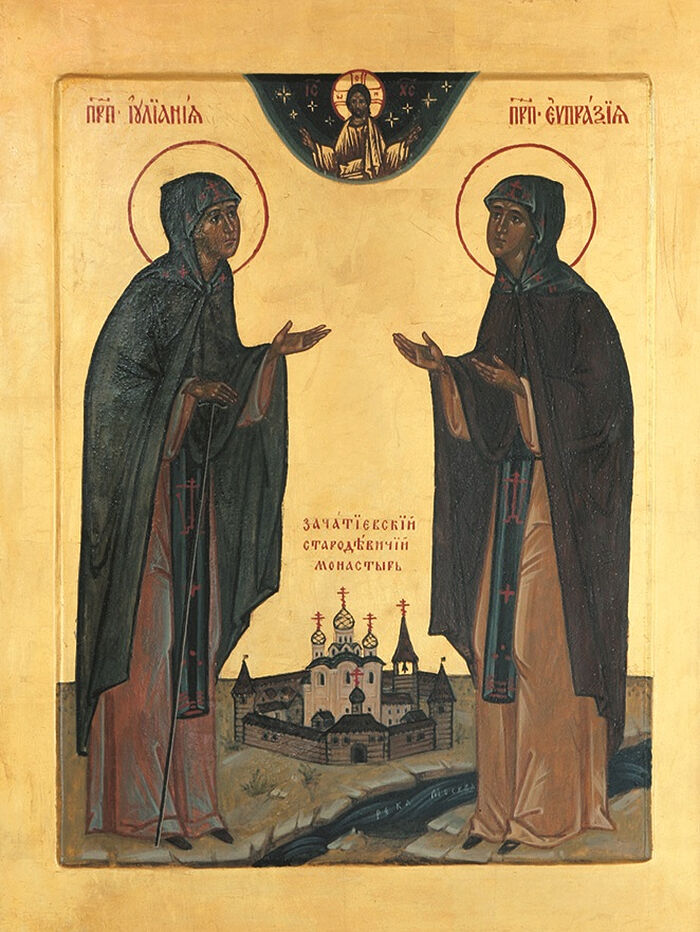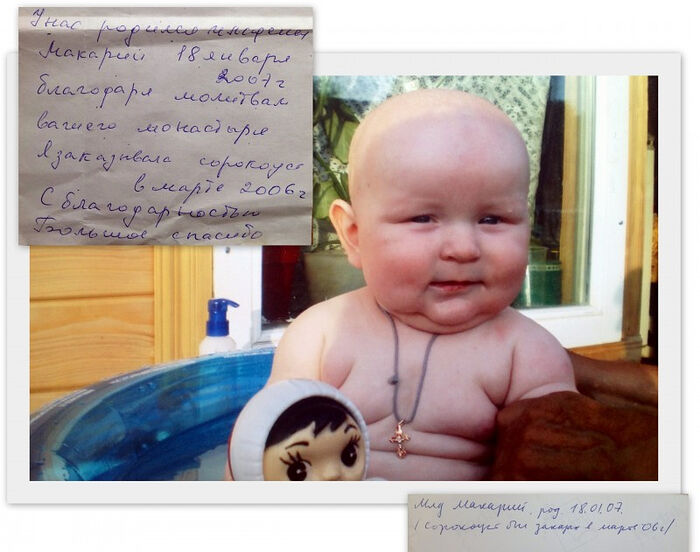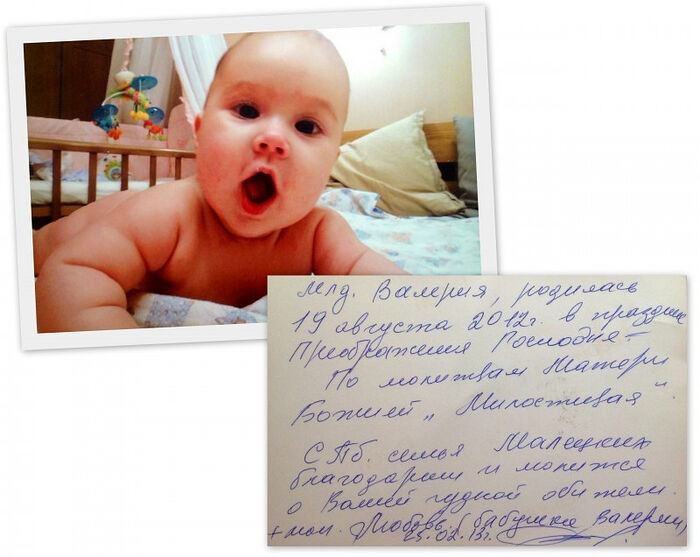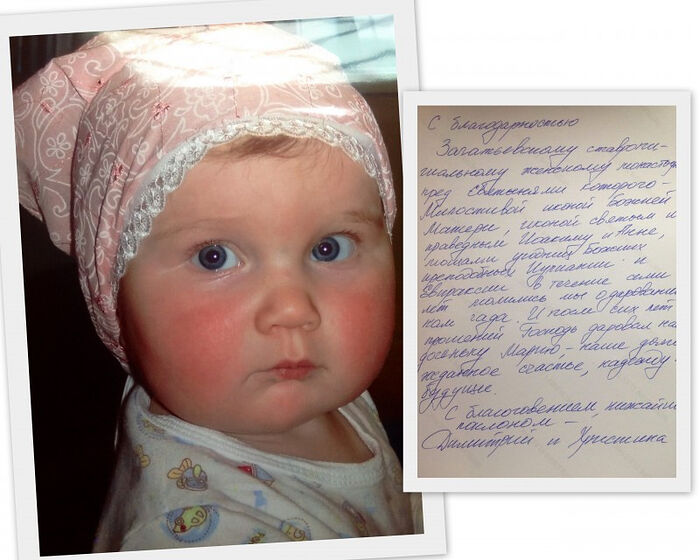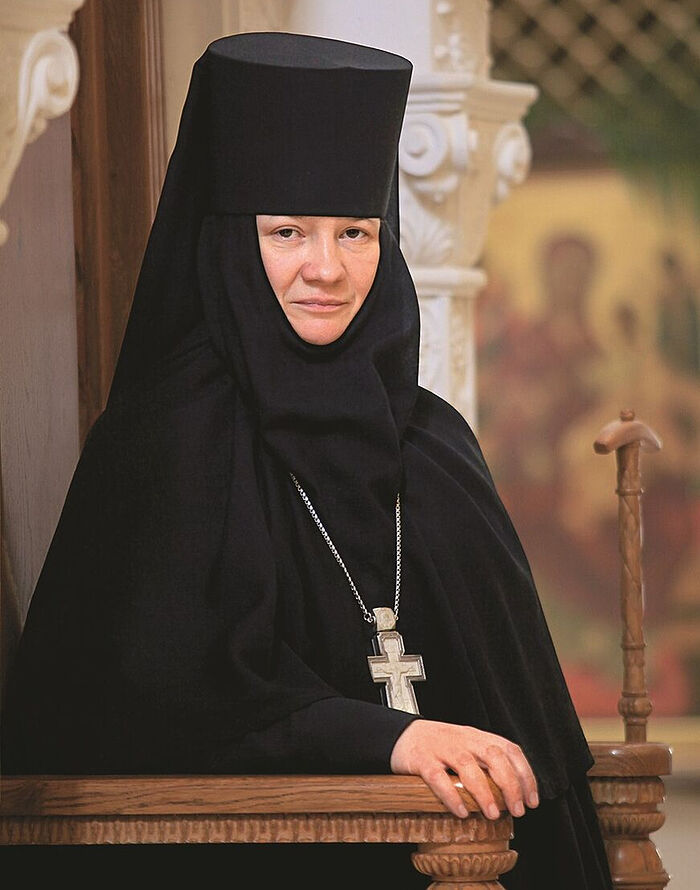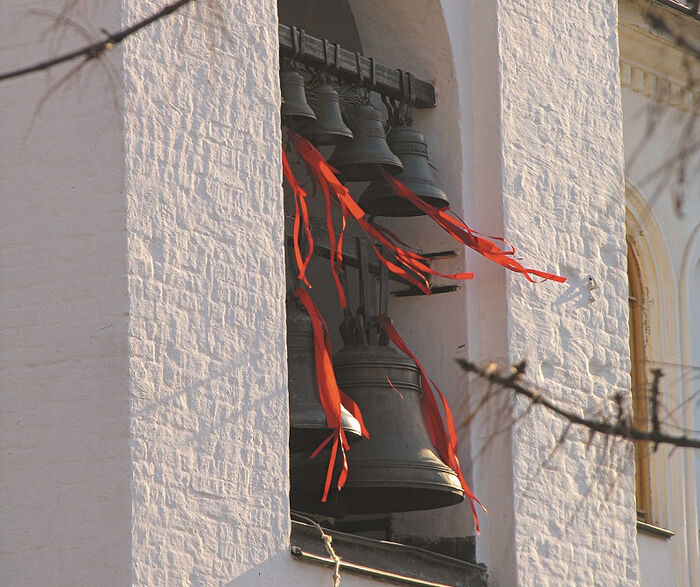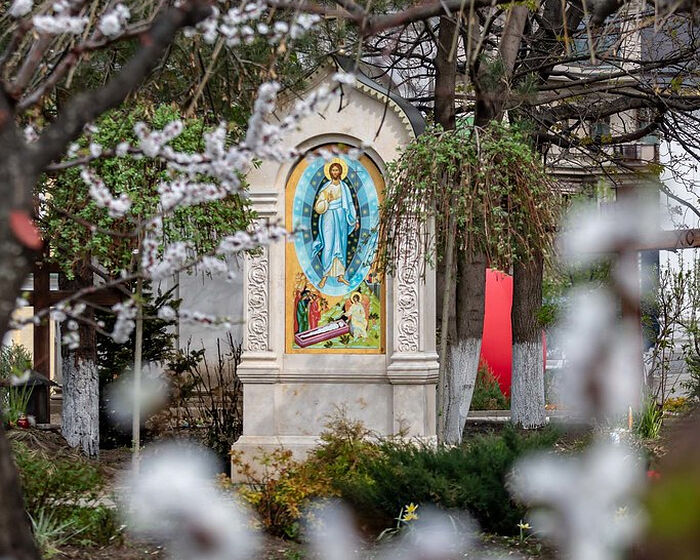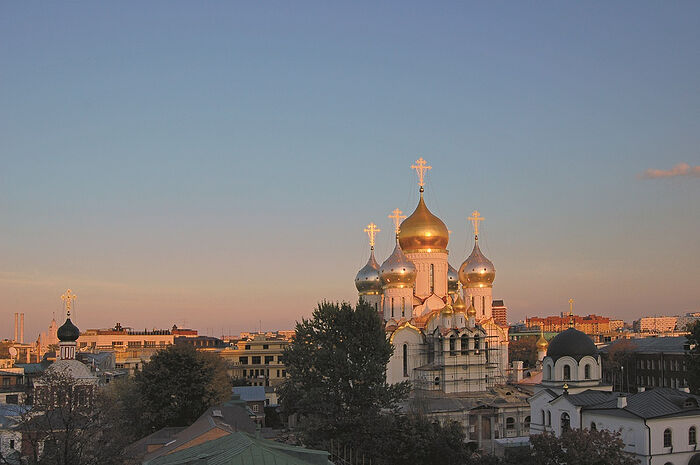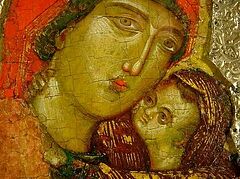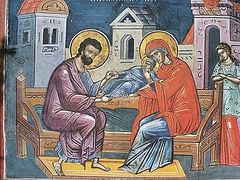This year, Moscow’s Holy Conception Monastery celebrated the twenty-fifth anniversary of its rebirth. September 22 was also a festive day there—the memory of Sts. Joachim and Anna, who are especially venerated in the monastery: It was precisely the joy of their miraculous conception of the Most Holy Virgin Mary, given to them to loose the bonds of childlessness, that gave the monastery its name.
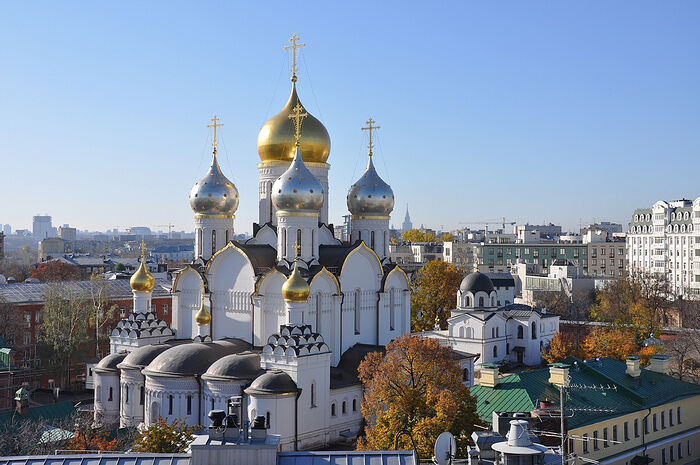 Moscow’s Holy Conception Monastery
Moscow’s Holy Conception Monastery
Orthodox spouses have been praying to Sts. Joachim and Anna at Holy Conception Monastery for the gift of children for centuries. By the goodwill of the Mother of God, by their prayers before the monastery’s “Joy of the Holy Righteous Joachim and Anna at the Most Holy Theotokos” Icon and the “Merciful and Helper in Childbirth” Icons of the Mother of God, and before the belt blessed on the Cincture of the Most Holy Theotokos, spouses even receive children after long being unable to conceive, just as once happened when the ancestors of God conceived the Most Holy Virgin Mary.
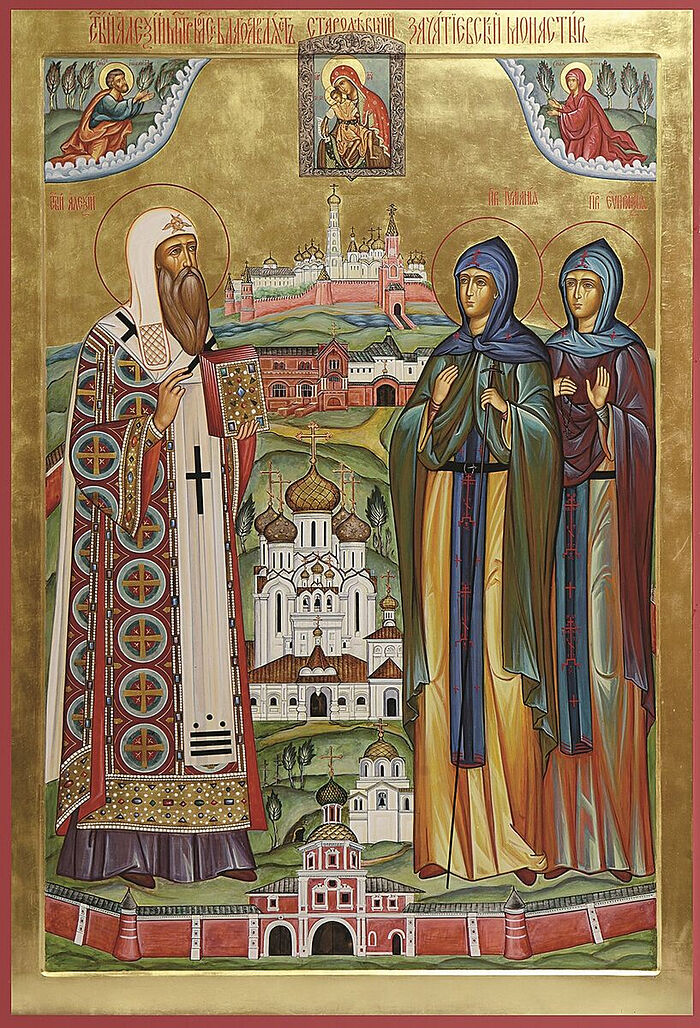 St. Alexei and his holy sisters Juliana and Evpraxia
St. Alexei and his holy sisters Juliana and Evpraxia
Conception Monastery, originally called the Monastery of St. Alexis, was founded more than six and a half centuries ago by St. Alexiy of Moscow who blessed his own sisters Ulyana and Julia to labor in monasticism; and they in turn, after being named Juliana and Eupraxia in their monastic tonsure, out of love for their brother named the monastery after his Heavenly patron—St. Alexis, the Man of God, who is known for breaking all family ties in order to labor in asceticism for the Lord. St. Alexiy and his canonized sisters Juliana and Eupraxia did not renounce their fleshly kinship, but simply sanctified it, having devoted their lives wholly to God. Perhaps, some kind of mystical connection was already established with those who seek to please God along with their relatives, and firstly with the holy household of Joachim and Anna, who dedicated the fruit of their many years together and prayers—the Most Holy Virgin Mary—to the Lord.
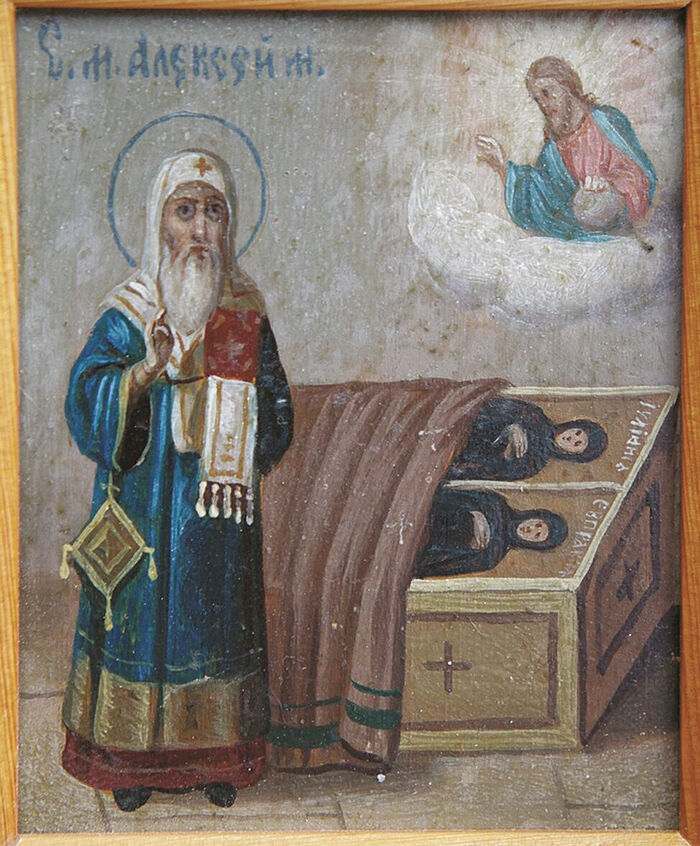 St. Alexei at the grave of his holy sisters Juliana and Eupraxia
St. Alexei at the grave of his holy sisters Juliana and Eupraxia
After the fire of 1514, Grand Duke Vasily Ioannovich, whose marriage to Solomonia Saburova was childless, rebuilt the St. Alexis Monastery. With his funds, a stone cathedral was built on the site of the first wooden church, with altars in honor of the Conception of the Holy Righteous Anna, the Transfiguration of the Lord, the Tikhvin Icon of the Mother of God, and St. Alexis, the Man of God (the wooden church had been dedicated to him). The Lord gave the Grand Duke an heir in his second marriage, who later became the first Grand Prince of Russia to assume the title of “Tsar”—Ivan IV, known as “the Terrible.” He, in turn, after the great fire of 1547, which incinerated wooden Moscow, allocated new lands to the monastery, closer to the Kremlin. Thus the “New St. Alexis Monastery Beyond the Chertory”1 was formed, with some of the inhabitants who remained from the old, ruined monastery. This monastery came to be known by the grace given to this place—“Holy Conception.”
With his accession to the all-Russian throne in 1584, Tsar Theodore Ioannovich, who grieved for the childlessness of him and his wife Irina Godunova, supported the monastery that was still devastated at that time. The monastery was rebuilt again under the care of the royal couple. One of the new churches was again consecrated in honor of the Conception of Righteous Anna, and another, the trapeza church, in honor of the Nativity of the Most Holy Theotokos. The benefactor’s prayers were answered. Thus, from century to century, the Mother of God has revealed the grace of childbearing to Christian families there.
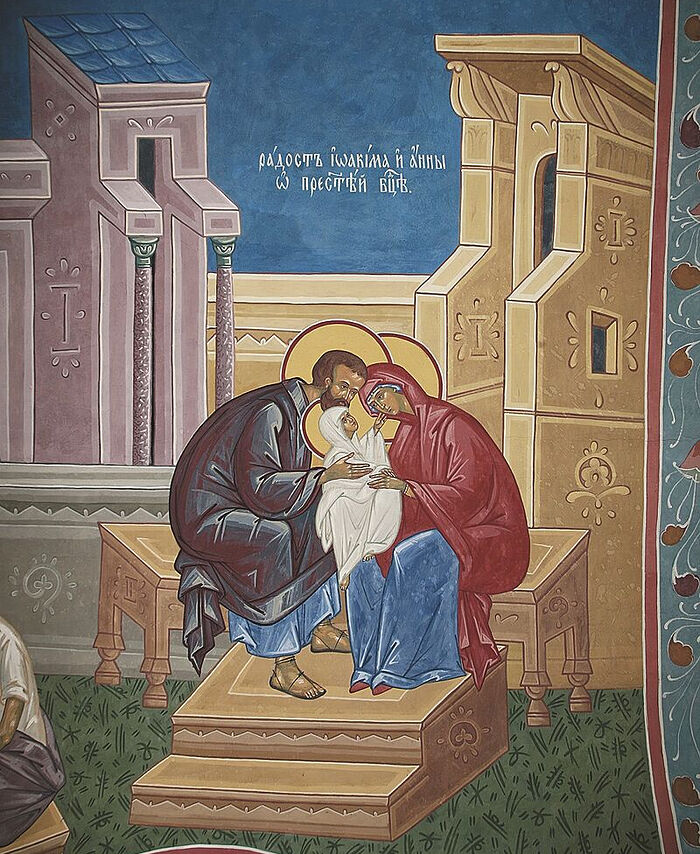 The joy of the Holy Righteous Joachim and Anna. Monastery fresco
The joy of the Holy Righteous Joachim and Anna. Monastery fresco
Now, a moleben with an akathist to the Holy Righteous Joachim and Anna for the gift of children and the familial wellbeing of the spouses is served every Saturday at noon in Holy Conception Monastery. Bishops and elders bless those who can’t conceive to go to Conception Monastery, to submit their names for this moleben and make sure they themselves are at the moleben, and commune in the monastery. We recently wrote about the story of Deacon Alexander Shevchenko—he and his wife had no children for three years, but after fulfilling Vladyka Alexei (Florov)’s blessing to pray at the icons at Conception Monastery, they ended up having many children.
Despite all the doctors’ diagnoses and admonitions, miracles of childbirth still happen here—then the happy parents bring photos of their newborns to the monastery:
Some of these children whose births were besought at the monastery grow up and become students of its Sunday School and parishioners of the monastery.
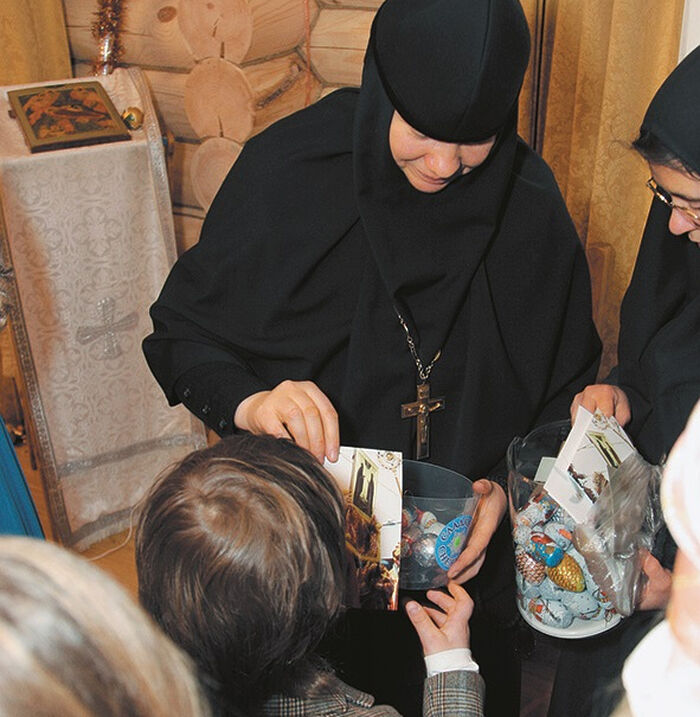 Mother Juliana (Kaleda) giving gifts to the children of the monastery’s Sunday School
Mother Juliana (Kaleda) giving gifts to the children of the monastery’s Sunday School
The monastery’s wonderworking “Merciful” Icon of the Mother of God, or “The Listener,” as it is also known (and the people simply call it the Mother of God With an Ear) is also a special grace-filled help in arranging marriages, families, and mothers. The Most Holy Theotokos is turned with her Child such that her ear is seen—and how many requests she has already heard, and how many she has fulfilled!
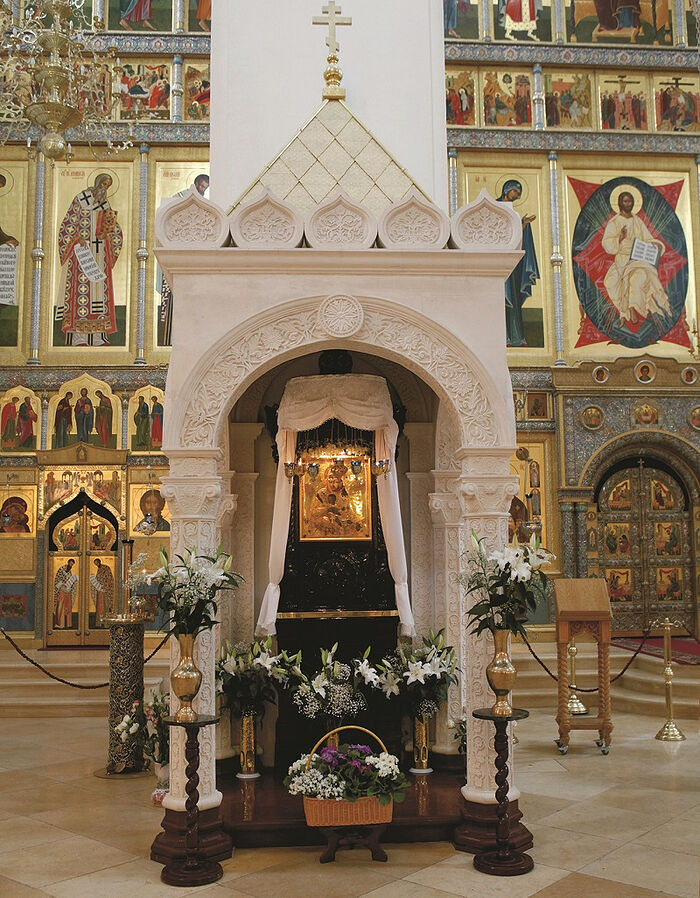 “The Merciful” Icon of the Mother of God
“The Merciful” Icon of the Mother of God
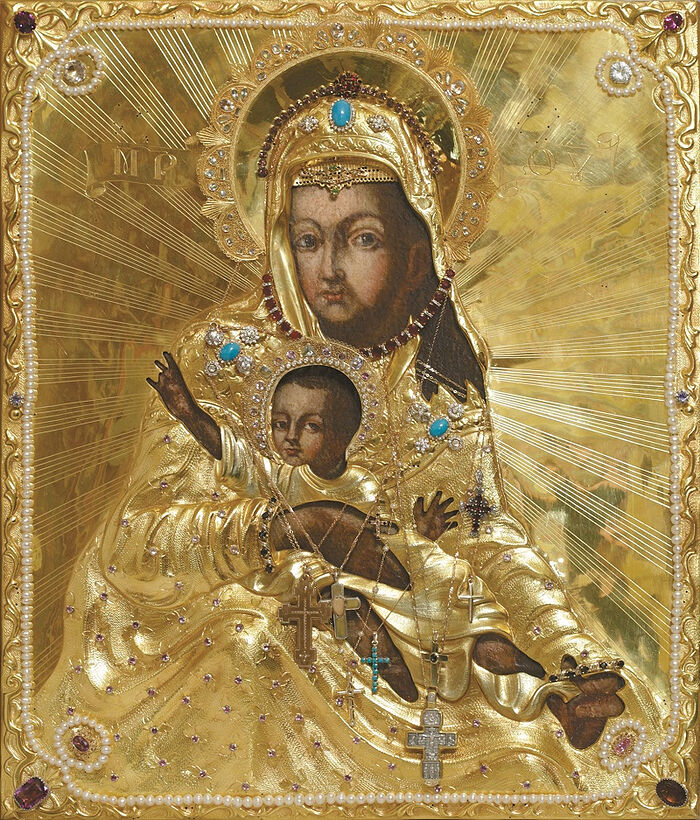 “The Merciful” Icon with its metal cover
“The Merciful” Icon with its metal cover
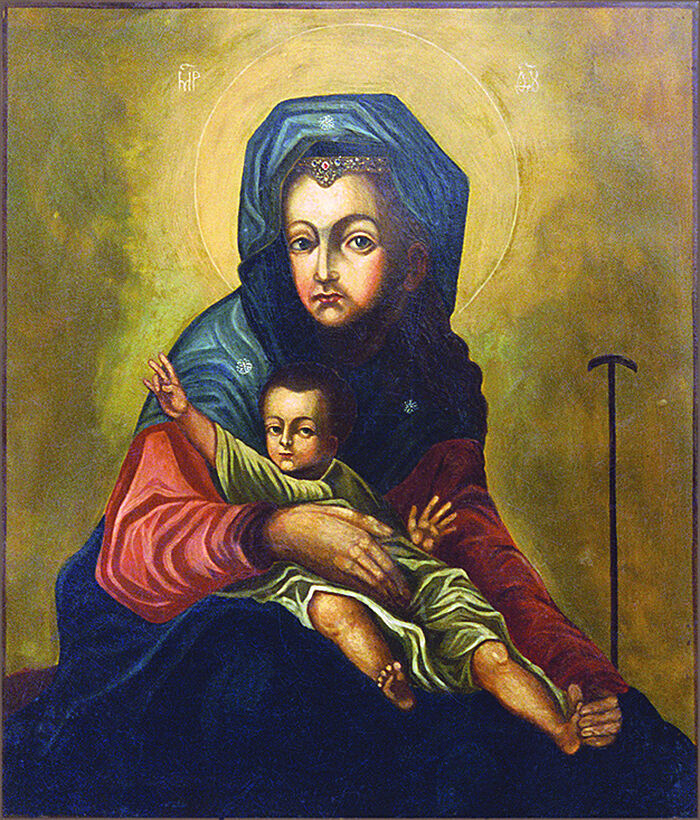 “The Merciful” Icon without the cover
“The Merciful” Icon without the cover
An atmosphere of tenderness and gratitude has always accompanied the life of this monastery, which marked the twenty-fifth anniversary of its rebirth this year.
A visible symbol of the restoration of the monastery was the construction of the Cathedral of the Nativity of the Most Holy Theotokos, which was destroyed in the 1930s. Majestic, bright, focused Heavenwards, it is designed to reflect the virgin purity of the Most Holy Theotokos.
There have been four cathedrals of various architecture on the territory of the monastery throughout its history. The first was the aforementioned wooden church, built under St. Alexiy. Then the first stone Church of the Conception of St. Anna was built in 1514 by the zeal of Grand Duke Vasily III, designed by the famous Italian architect Aleviz Fryazin, who built the Archangel Cathedral in the Kremlin. This church burned down during the great Moscow fire of 1547 during the reign of Ivan the Terrible; the third cathedral was built in the late sixteenth century by Tsar Theodore Ioannovich and existed until the early nineteenth century. By that time, it had fallen into disrepair. It was dismantled, and 213 years ago, in 1807, a new one was built—the Cathedral of the Nativity of the Theotokos. This neo-Gothic church is attributed to the famous architect M. F. Kazakov.
In 1934, during the ruin of the monastery under soviet rule, this church was demolished.
 The destruction of Conception Monastery under the soviet authorities
The destruction of Conception Monastery under the soviet authorities
And in our times, with the blessing of His Holiness Patriarch Alexiy II, a new cathedral was built in the ancient Russian style.
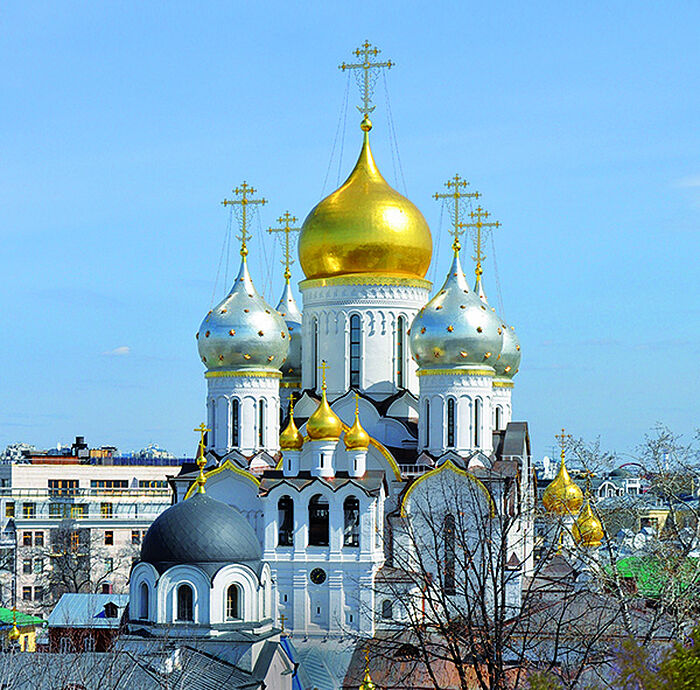 Conception Monastery. The Cathedral of the Nativity of the Most Holy Theotokos
Conception Monastery. The Cathedral of the Nativity of the Most Holy Theotokos
Despite all the difficulties that tried to defeat the abbess and nuns in the reviving monastery, the late twentieth to early twenty-first centuries—the Second Baptism Rus’, as this period is called—was a bright time of the joyous return of the country to Christ, under the lifegiving grace of the Holy Spirit and the maternal care of the Most Holy Theotokos, who, by her prayers did not leave even the wayward children of God.
For all those involved in this celebration of the Holy Spirit’s revival of Orthodoxy, there could be no question of restoring the gloomy, neo-Gothic church, tearing the sky with its spires, in the very center of the primatial city, in this old corner of Ostozhenka.2 The sisters longed for a return to Holy Rus’, and the Cathedral of the Nativity of the Most Holy Theotokos that we see today became a visible embodiment of their aspiration.
The abbess of Conception Monastery, Mother Juliana (Kaleda), speaks about the dedication of the altars of the restored cathedral:
—First we wanted to restore historical justice—to rebuild all the altars that have existed throughout the history of the monastery. In the life of the monastery, it turned out that one cathedral burned, and another was built; some altars were ruined, and new ones were consecrated. Our main altar is dedicated to the Nativity of the Most Holy Theotokos, as it was in the last cathedral.
The second altar is dedicated to St. Alexiy, the founder of the monastery, as in the late-sixteenth century cathedral, and to St. Alexis, the Man of God, because our monastery was originally named in his honor, as the Heavenly patron of St. Alexiy.
Next is the altar of the Holy Righteous Joachim and Anna, the Heavenly patrons of our monastery, as the monastery has been named Holy Conception since the sixteenth century.
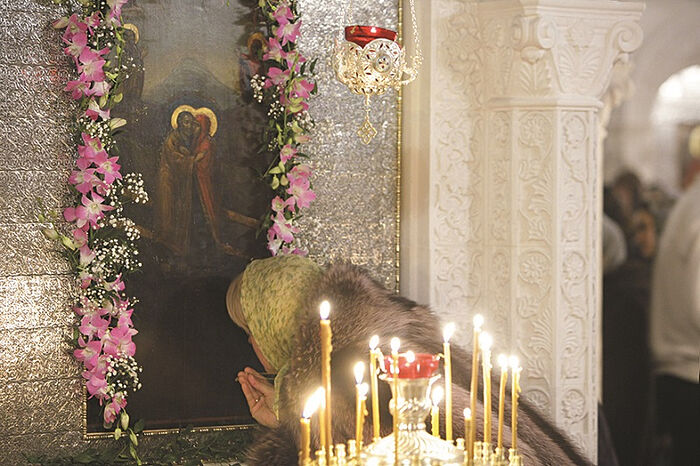 The ancient monastery icon of the Conception of the Holy Righteous Anna
The ancient monastery icon of the Conception of the Holy Righteous Anna
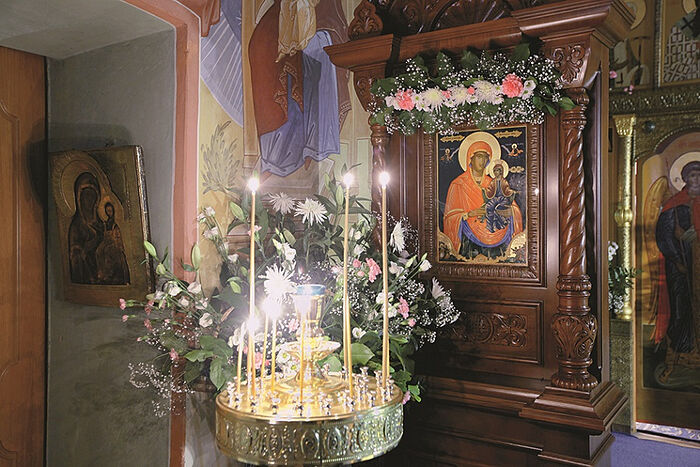 St. Anna with the Virgin Mary
St. Anna with the Virgin Mary
We have also restored the old altars dedicated to the “Kazan” Icon of the Mother of God and the “Burning Bush” Icon. These altars are connected with the memory of our venerable founders, Abbess Juliana and Nun Eupraxia. According to tradition, on the site of their burial, a church was built originally in honor of the “Burning Bush” Icon, and then, since it was small and not heated, the altar was dismantled, the church was enlarged and connected to the cathedral, and consecrated in honor of the “Kazan” Icon of the Most Holy Theotokos.
In 2001, our foundresses were canonized as venerable nuns, and now one of the altars is dedicated to them as the originators of our monastic life and our patronesses.
Another altar is dedicated to Hieromartyr Cyprian and Martyr Justina. Seven years ago, they brought the relics of these saints from Cyprus, and a piece of them remained with us. At that time, Metropolitan Neophytos (Masuras) of Morphou, who headed the Cypriot delegation, expressed the wish that we might consecrate some chapel or altar in the name of Sts. Cyprian and Justina. These saints are very beloved by the sisters and the people who always come on Tuesdays at 12:00 PM to the moleben before their icon with their relics. Thus, with the blessing of His Holiness Patriarch Kirill, it was decided to dedicate the altar to these saints.
There are two more altars that didn’t previously exist in the history of the monastery. The first is dedicated to the Great Martyr Demetrios of Thessaloniki, the Heavenly patron of our main benefactor, at whose expense the cathedral was primarily built.
The second altar is dedicated to the Right-believing Princess Juliana of Vyazma, a wonderous saint whom the sisters greatly venerate—she helped us with the construction. She is my Heavenly patron. The sisters really wanted an altar named for her too, and the Patriarch gave his blessing.
In the basement there is an altar named for the holy fathers and mothers who have shone forth in the podvigs of fasting and prayer, which not only never existed, but wasn’t even conceived of in the original plan for the rebuilt cathedral.
***
It’s better to see the monastery, at least in photographs. But it’s even more gratifying to visit it.
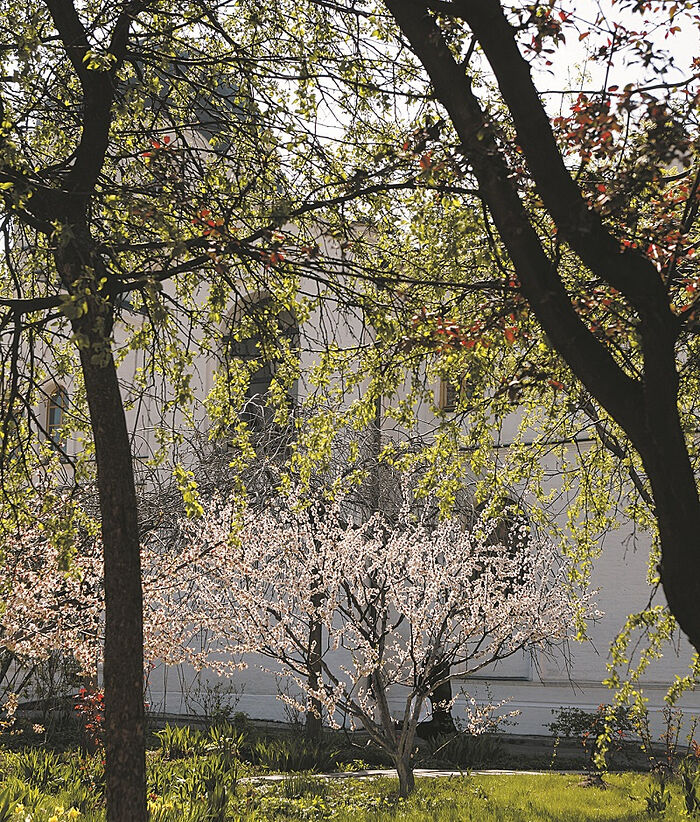 Conception Monastery in spring
Conception Monastery in spring
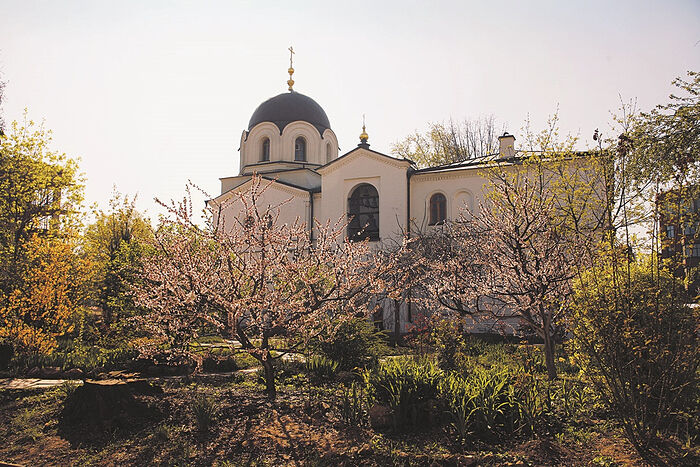 Church of the Descent of the Holy Spirit
Church of the Descent of the Holy Spirit
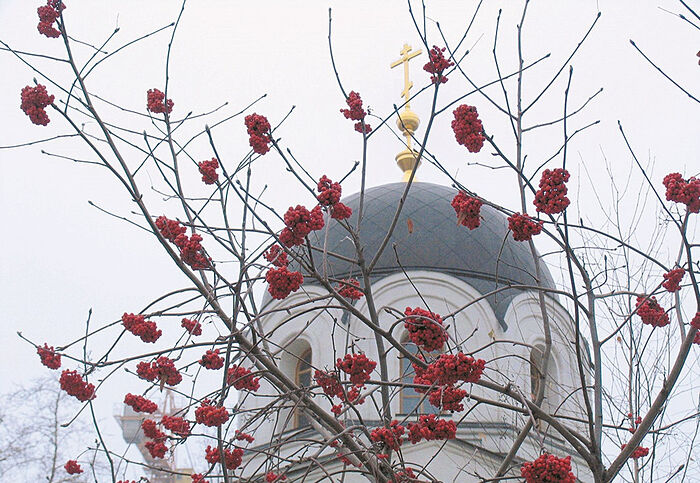 Church of the Descent of the Holy Spirit
Church of the Descent of the Holy Spirit
 “What is a monastery without a garden?” Fr. Alexander Egorov said to his spiritual daughter, Abbess Juliana, during the restoration of the monastery
“What is a monastery without a garden?” Fr. Alexander Egorov said to his spiritual daughter, Abbess Juliana, during the restoration of the monastery
 The Merciful Icon of the Mother of God
The Merciful Icon of the Mother of God
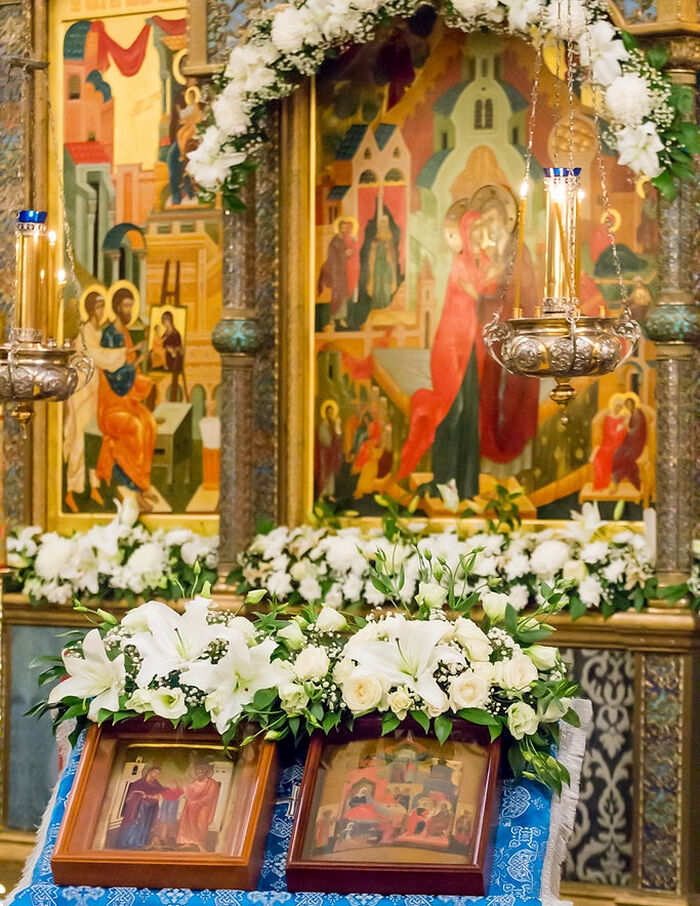 The feast of Sts. Joachim and Anna at the monastery
The feast of Sts. Joachim and Anna at the monastery
 The construction of the Cathedral of the Most Holy Theotokos. Bricks with benefactors’ names
The construction of the Cathedral of the Most Holy Theotokos. Bricks with benefactors’ names
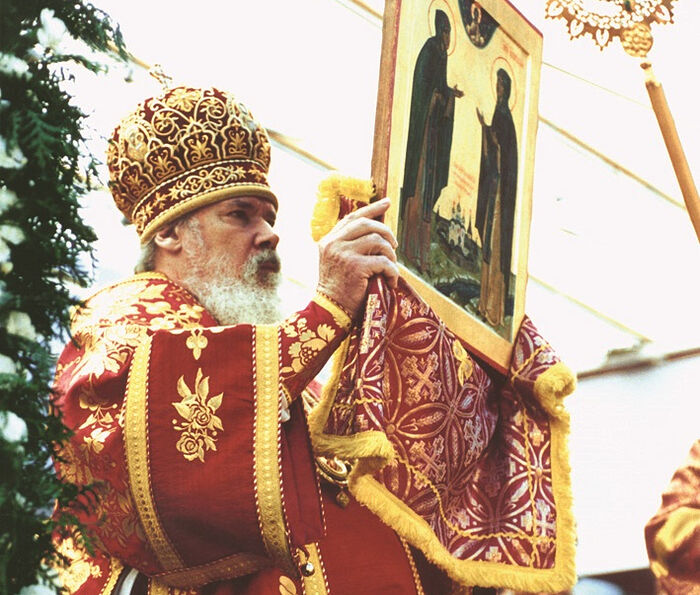 The blessing of His Holiness Patriarch Alexei II
The blessing of His Holiness Patriarch Alexei II
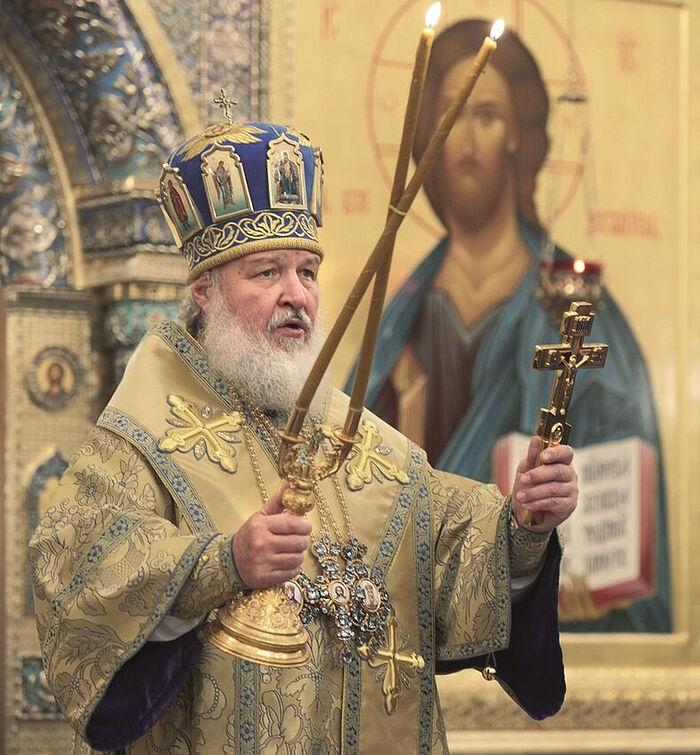 His Holiness Patriarch Kirill serving at the monastery
His Holiness Patriarch Kirill serving at the monastery
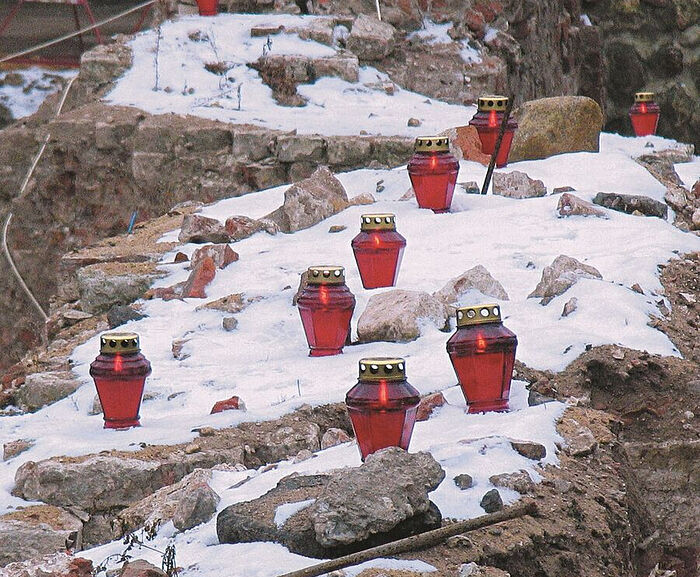 Memorial lampadas during the construction of the cathedral
Memorial lampadas during the construction of the cathedral
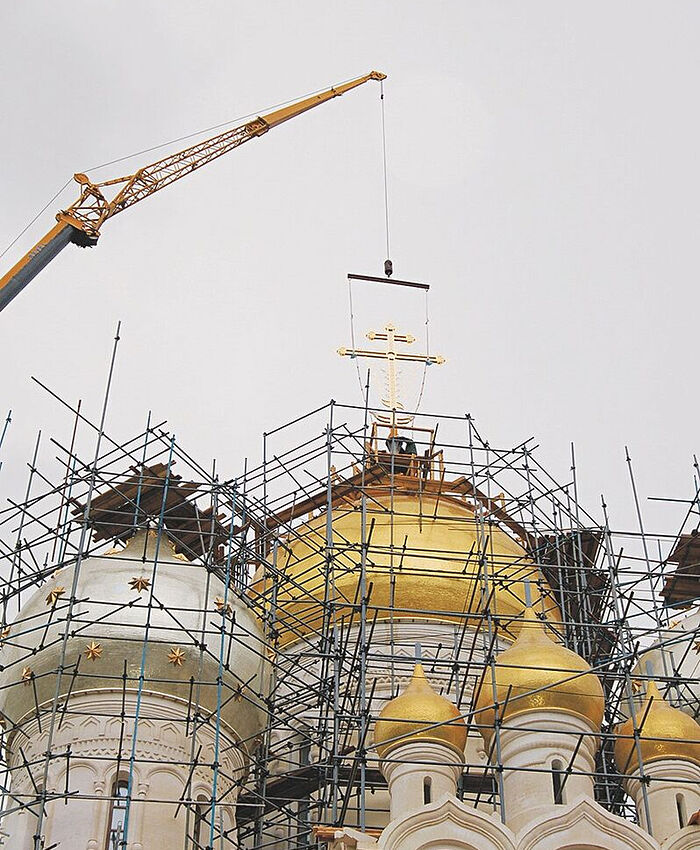 Installing the cross on the Cathedral of the Nativity of the Most Holy Theotokos
Installing the cross on the Cathedral of the Nativity of the Most Holy Theotokos

